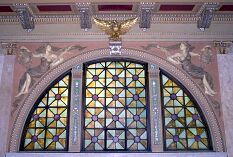Levels of legality
From the first floor to the third, structure contains architectural and historical treasures.
By William Carlton
of The News-Sentinel
 |  |  |  | News-Sentinel photo by Brian Tombaugh
| | Symbolic of the areaSituated above a large stained-glass window on the stairway between the first and second floors of the Allen County Courthouse are two figures symbolizing Allen County, left, and the city of Fort Wayne, right. |
|
|
Pass through the ornate triple doors flanked by mighty granite columns and prepare to be floored by the Allen County Courthouse.
There are three public levels radiating around an awesome rotunda arching high with allegorical murals and a stained-glass ceiling. It's practically a civic equivalent of the Sistine Chapel.
Here's the layout of the original floor plans.
First floor: Offices of the township trustees, sheriff, surveyor, assessor, coroner, health officials, superintendent of public schools, engineer and custodian. Ample space also was set aside for an assembly room for public meetings.
The cornerstone of the previous county courthouse, built in 1862 at the same site, is embedded in a wall fronting the north elevator shaft. In the vestibule of the west lobby entrance, a pneumatic clock enclosed in glass used to regulate the courthouse's tower clocks and 32 other clocks. The clocks now have separate power supplies.
On the first-floor stairway landings are portraits of the county's namesake, Col. John Allen, who aided in the relief of Fort Wayne during the War of 1812; and Samuel Hanna, the county's first judge.
On the east stairway landing is a large bronze memorial tablet informing visitors the building was ordered Sept. 4, 1895, and construction completed Oct. 3, 1900. Work on the building's interior continued until 1902. The top executives of the county commission are listed as are the architect, Brentwood Tolan; the building inspector, Henry Jensen; the building superintendent, William Goshorn; and the contractor, James Stewart & Co.
Above the tablet and framing the upper arch of a stained-glass window are two sculptures -- a woman holding a stalk of corn representing the products of the rural district and a sister figure holding a distaff (a pole for winding fibers before they are spun) representing the city's industry.
Second floor: It was reserved for offices of the county auditor, treasurer and clerk, record rooms and the county commissioners courtroom, all spacious and handsomely appointed.
Third floor: Called the judiciary floor, it has four magnificent courtrooms -- Superior Court, considered the handsomest, Circuit Court and courtrooms Nos. 2 and 3.
The courtrooms are festooned with scagliola-clad columns and other decorative details, such as rich mahogany furnishings and murals depicting the early history of this region as well as the ideals of justice, government, the arts, science and industry.
The third-floor plan also laid out jury rooms, witness rooms, private consulting rooms, judges' chambers and a law library with 2,000 volumes, many rare and very valuable. The rooms were connected by separate corridors. Stairways led to balconies overlooking the rotunda murals and to an outside view of the city. Both balconies later closed to the public for safety reasons.
Because the building was designed to handle the needs of a growing population well into the future, one of the third-floor courtrooms originally was vacant. The county commissioners allowed the Mary Penrose Wayne Chapter of the Daughters of the American Revolution to transform courtroom No. 3, and later No. 2, into the city's first museum with artifacts on local history.
The Relic Room, as it was known, eventually became the Allen County-Fort Wayne Historical Society, founded in 1921 and now based in The History Center in the old City Building at Berry and Barr streets. Items from the War of 1812 and the Civil War formed the core collection, which soon grew to include a painting of Gen. Anthony Wayne, the general's camp bed, a candlestick used by George Washington and a maul (a heavy mallet used for driving stakes) reportedly made by Abraham Lincoln.
The Relic Room closed in 1926 after the historical society relocated to the Swinney Homestead. The courtrooms it occupied reverted to their intended purpose -- a forum for legal battles where county history is made.